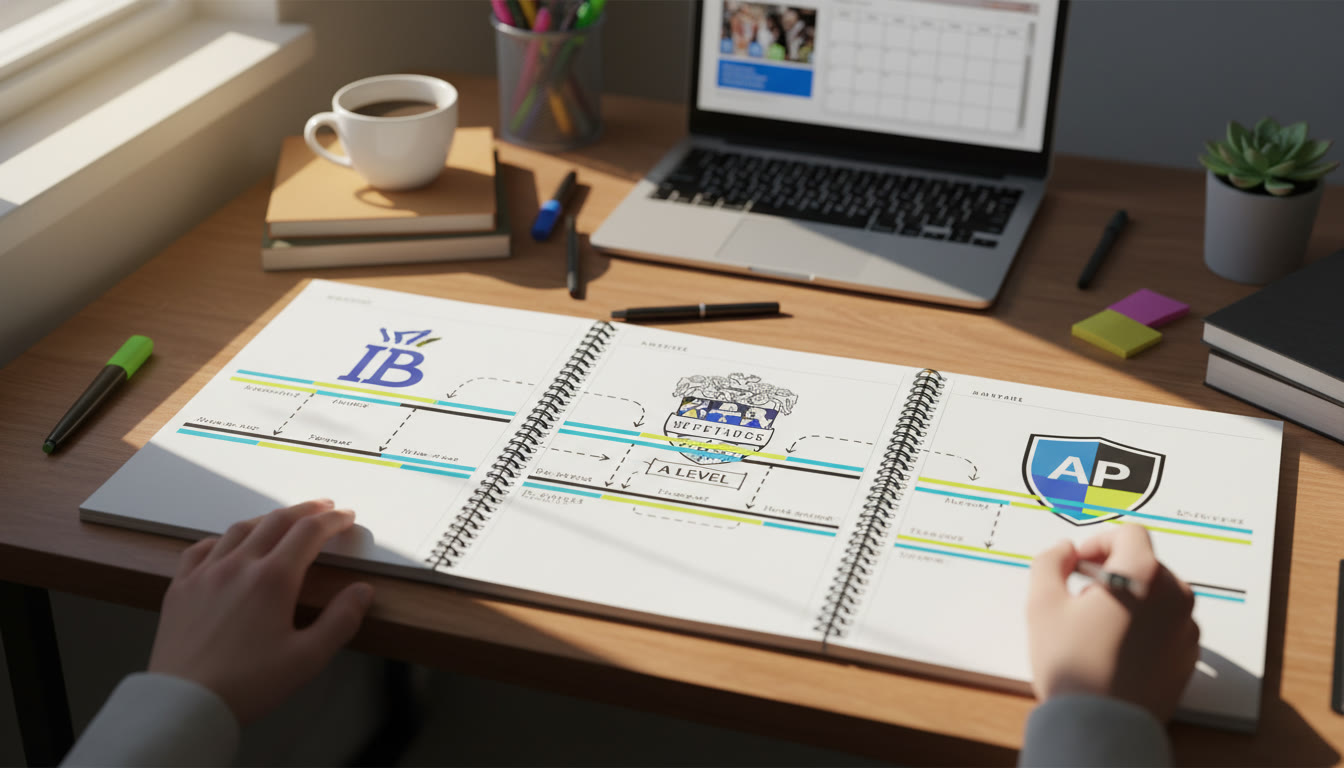Why This Comparison Matters: Different Roads to the Same Past
Students who move between international curricula — IB, A Level, and the College Board’s AP courses — often feel like they’re learning different languages for the same story. That’s because each system organizes historical study with a distinct purpose: IB and A Level emphasize thematic depth, comparative skills, and historiographical awareness; AP emphasizes analytical skill-building through content-rich frameworks and question types designed for college readiness. Understanding how periodization (the act of dividing history into meaningful chunks) in IB/A Level maps onto AP frameworks arms you with study strategies that transfer seamlessly between exams and real-world historical thinking.

What Is Periodization — and Why Do Different Systems Use It?
Periodization is more than putting dates on a timeline. It’s an interpretive tool historians use to highlight continuities, ruptures, and turning points. Different curricula choose period boundaries based on pedagogical goals:
- IB (International Baccalaureate): Often organizes history around global themes and interconnected developments, encouraging students to compare regions and engage with multiple perspectives.
- A Level: Usually focuses on national depth or thematic depth (e.g., Britain, Germany, or the idea of revolution), with strong emphasis on source analysis and historiography.
- AP: Designed to develop skills recognized by U.S. colleges — document analysis, evidence-based argumentation, and chronological reasoning — with content presented in clearly defined periods that align with exam rubrics.
When you learn how to translate periodization across systems, you can take the critical thinking skills built in one curriculum and apply them to the expectations of another.
Core Periods: A Practical Crosswalk
Below is a practical crosswalk that shows how common historical periods in IB/A Level curricula map to AP frameworks. This is a flexible guide — think of it as a translator, not a law.
| IB / A Level Period | Typical Focus | Equivalent AP Periods / Themes |
|---|---|---|
| Early Modern (c. 1450–1750) | Exploration, state formation, global exchanges | AP Period 4 (Colonialism and Contact) & Period 5 (Revolutions and Nation-States) |
| Industrial and Political Revolutions (c. 1750–1914) | Industrialization, ideological shifts, empire | AP Period 5 (Expansion, Reform, Revolution) & Period 6 (Industrialization) |
| 20th Century Transformations (c. 1914–1991) | World wars, decolonization, Cold War | AP Period 7–8 (Global Conflicts, Cold War, Decolonization) |
| Contemporary Era (c. 1991–present) | Globalization, cultural change, transnational challenges | AP Period 9 (Contemporary Global Connections) |
Note: AP uses numbered periods (often grouped in AP rubrics), with clear skill expectations tied to each. When translating, focus less on rigid dates and more on the themes and skills expected in the AP exam.
How To Convert Your IB/A Level Knowledge Into AP Exam Success
Students from IB/A Level backgrounds already have many transferable strengths — thematic thinking, essay structure, and source critique. To align those strengths with AP expectations, try these strategies:
1. Re-slice your timelines by AP themes
Instead of rehearsing topics by module, reframe them around AP themes such as: change and continuity, cause and consequence, comparison, and development of national identities. For example, take an A Level unit on the French Revolution and practice discussing it through the lens of AP themes: what were the long-term causes (continuity), the triggers (change), and comparative implications (how did revolution in France compare to revolution in Latin America)?
2. Practice AP question formats
AP exams use particular question types (short-answer, document-based essay, long essay). Translate an IB source analysis into a Document-Based Question (DBQ) by grouping your IB/A Level sources into sets and practicing thesis-driven essays with explicit use of evidence and contextualization.
3. Focus on synthesis and comparison
IB’s comparative edge is a gift. AP loves synthesis — connecting themes across periods and regions. Make deliberate practice time for brief essays that compare a phenomenon across different regions or time periods (e.g., compare industrialization in Britain with industrialization in Meiji Japan).
4. Quantify your content with timelines and cause maps
Create visual tools that align with AP’s chronological reasoning: timelines of key events with causal arrows show how short-term events relate to long-term trends. These are especially helpful when translating A Level depth into AP breadth.
Sample Study Plan: 12 Weeks to an AP Exam Starting from an IB/A Level Foundation
This condensed plan assumes you already have solid content knowledge from IB or A Level and need to target AP exam skills. Adjust pacing by your base knowledge and exam date.
| Weeks | Focus | Activities |
|---|---|---|
| 1–2 | Mapping and Orientation | Map syllabus topics to AP periods; build master timeline; identify weak spots. |
| 3–5 | Document Skills and Short Answers | Practice DBQ source analysis; write short-answer responses under timed conditions. |
| 6–8 | Long Essays and Comparison | Write long essays on cross-period themes; practice synthesizing IB comparative essays into AP long-essay format. |
| 9–10 | Mock Exams and Time Management | Full practice exams; review scoring rubrics; refine timing strategies. |
| 11–12 | Targeted Review and Confidence Building | Focused drills on weakest areas; light review; mental preparation and exam routines. |
Common Pitfalls and How to Avoid Them
Students moving between curricula often fall into familiar traps. Watch out for these and use targeted fixes.
Pitfall: Over-detailing at the Expense of Argument
IB and A Level both reward deep content knowledge; AP rewards that too, but only when it’s used to support a clear argument. If your essays are dense with facts but lack a guiding thesis, graders lose the thread. Fix: Start each response with a one-sentence thesis that answers the prompt directly. Then scaffold your paragraphs around evidence that ties back to that thesis.
Pitfall: Misreading Question Demands
AP prompts often include specific tasks (compare, analyze causes, evaluate consequences). Students from other curricula sometimes write what they know rather than what’s asked. Fix: Underline the task words before you write, and plan an outline that addresses each task explicitly.
Pitfall: Treating Sources as Background Instead of Evidence
IB source work is often nuanced and interpretive. For AP DBQs, sources are evidence you must explicitly incorporate. Fix: When using a source, name it, summarize its main point in one line, and explain precisely how it supports your argument.
Examples: Translating Sample Prompts
Here are two quick examples showing how to adapt an IB/A Level approach to AP-style answers.
Example 1 — From Thematic Essay to AP Long Essay
IB Prompt (example): “Discuss the extent to which nationalism shaped political developments in the 19th century.”
AP Adaptation: Re-frame into an AP long-essay prompt like, “Evaluate the role of nationalism in the political unification and fragmentation processes of the 19th century. Use comparative evidence.”
Approach: Craft a thesis that sets up a comparison (e.g., unification in Germany vs. fragmentation in the Ottoman Balkans), then use two or three well-chosen pieces of evidence and tie them back to causation and consequence.
Example 2 — From Source Evaluation to DBQ
A Level Source Task (example): “How useful is Source A for understanding the economic policies of X?”
AP DBQ Adaptation: Group several A Level sources with additional documents and write a DBQ-style thesis that synthesizes the evidence to make a broader argument about economic policy and its impacts.
Approach: For each document, do a mini-analysis: identify the author’s perspective, context, and the document’s contribution to your thesis. Then, include outside evidence to show depth.
Tools That Help Translate Skills Quickly
Some practical tools speed the transfer of skills between curricula:
- Master timelines with layered annotations (dates, causes, consequences, historiographical notes).
- Cause-and-effect maps that convert descriptive A Level essays into analytical AP arguments.
- DBQ practice sets assembled from your IB/A Level source banks.
- Rubric checklists: after drafting, run your essay against AP rubric points (thesis, contextualization, evidence, analysis, synthesis).
How Tutoring Can Make the Bridge Shorter
One-on-one guidance accelerates the adaptation process. Tailored tutoring helps you identify which IB/A Level habits are strengths and which need reshaping for AP. For instance, a tutor can:
- Develop personalized study plans that take advantage of your IB/A Level background while targeting AP-style questions.
- Provide focused feedback on DBQs and long essays, showing precisely where argumentation or evidence usage can be tightened.
- Use AI-driven insights to track progress and adjust practice tests to your evolving needs.
Services like Sparkl’s personalized tutoring offer these benefits naturally — pairing expert tutors with tailored study plans and data-driven feedback, which is especially helpful for students shifting between curricula.
Sample Rubric: Converting an IB Essay Into an AP-Style Checklist
Use this quick rubric as a self-check after you write an essay.
| AP Rubric Component | What to Check | IB/A Level Habit to Leverage |
|---|---|---|
| Thesis | Clear, direct, answers the prompt in one sentence | Use the IB topic sentence habit to craft a thesis that frames your argument. |
| Contextualization | Situate argument within broader historical developments | Adapt A Level depth on background to concise, relevant context for AP. |
| Evidence | Specific and relevant; used to support claims | Turn IB/A Level factual knowledge into targeted evidentiary points for AP. |
| Analysis | Explain why evidence matters; link to the thesis | Convert A Level source commentary into explicit cause/effect analysis. |
| Synthesis | Make a broader connection across time, place, or discipline | Use IB comparative skills to craft a strong synthesis sentence. |
Real-World Context: Why Colleges Value Both Approaches
Colleges look for historians who can handle complexity: students who can combine deep knowledge with analytical clarity. IB and A Level teach nuance, research habits, and historiography; AP demonstrates readiness to perform at a college level under time constraints with clear, evidence-based argumentation. Students who can show both are well positioned for success in undergraduate history programs and beyond.

Final Tips: Make the Transition Smooth and Sustainable
- Don’t throw away your strengths: keep IB/A Level habits that promote depth and context; just package them into concise AP responses.
- Use practice exams to calibrate pace; AP timing is as much a skill as content mastery.
- Practice targeted evidence use — two or three powerful pieces beat an unfocused flood of facts.
- Ask for feedback, ideally from someone familiar with AP rubrics. Personalized tutoring that aligns with your background — for instance Sparkl’s 1-on-1 guidance with tailored study plans and expert tutors — can dramatically shorten the learning curve.
- Develop a signature essay structure that you can adapt quickly to any prompt: Thesis → Context → Evidence/Analysis chunks → Synthesis.
Parting Thought: Think Like a Historian, Act Like an AP Student
Periodization is a historian’s map, but the map’s usefulness depends on how you use it. IB and A Level give you a rich cartography of causes, forces, and interpretations; AP asks you to walk that map quickly and convincingly. By learning to translate depth into focused argument — and by using structured tools, timed practice, and targeted feedback — you’ll not only bridge curricula, you’ll deepen your historical thinking in ways that serve you in college and life.
Want to move faster? Consider pairing your study routine with a tutor who understands both worlds. With tailored plans, focused DBQ practice, and data-driven progress tracking, a targeted approach can make the difference between knowing history and proving it on exam day.
Good luck — and remember: the most compelling historical arguments are those that combine curiosity, clarity, and courage. You’ve already got the curiosity. The rest is practice.




















No Comments
Leave a comment Cancel